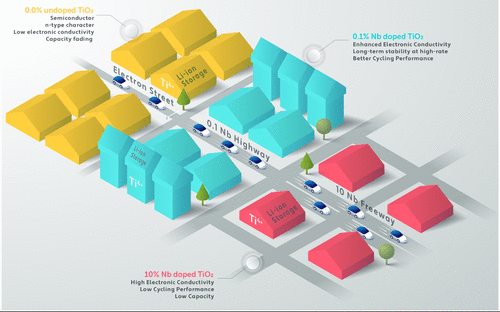当前位置:
X-MOL 学术
›
ACS Appl. Energy Mater.
›
论文详情
Our official English website, www.x-mol.net, welcomes your feedback! (Note: you will need to create a separate account there.)
Effect of the Niobium Doping Concentration on the Charge Storage Mechanism of Mesoporous Anatase Beads as an Anode for High-Rate Li-Ion Batteries
ACS Applied Energy Materials ( IF 6.4 ) Pub Date : 2020-12-17 , DOI: 10.1021/acsaem.0c02157 Carmen Cavallo 1, 2 , Giulio Calcagno 3 , Rodrigo Pereira de Carvalho 4 , Matthew Sadd 2 , Bruno Gonano 1 , C. Moyses Araujo 4 , Anders E.C. Palmqvist 3 , Aleksandar Matic 2
ACS Applied Energy Materials ( IF 6.4 ) Pub Date : 2020-12-17 , DOI: 10.1021/acsaem.0c02157 Carmen Cavallo 1, 2 , Giulio Calcagno 3 , Rodrigo Pereira de Carvalho 4 , Matthew Sadd 2 , Bruno Gonano 1 , C. Moyses Araujo 4 , Anders E.C. Palmqvist 3 , Aleksandar Matic 2
Affiliation

|
A promising strategy to improve the rate performance of Li-ion batteries is to enhance and facilitate the insertion of Li ions into nanostructured oxides like TiO2. In this work, we present a systematic study of pentavalent-doped anatase TiO2 materials for third-generation high-rate Li-ion batteries. Mesoporous niobium-doped anatase beads (Nb-doped TiO2) with different Nb5+ doping (n-type) concentrations (0.1, 1.0, and 10% at.) were synthesized via an improved template approach followed by hydrothermal treatment. The formation of intrinsic n-type defects and oxygen vacancies under RT conditions gives rise to a metallic-type conduction due to a shift of the Fermi energy level. The increase in the metallic character, confirmed by electrochemical impedance spectroscopy, enhances the performance of the anatase bead electrodes in terms of rate capability and provides higher capacities both at low and fast charging rates. The experimental data were supported by density functional theory (DFT) calculations showing how a different n-type doping can be correlated to the same electrochemical effect on the final device. The Nb-doped TiO2 electrode materials exhibit an improved cycling stability at all the doping concentrations by overcoming the capacity fade shown in the case of pure TiO2 beads. The 0.1% Nb-doped TiO2-based electrodes exhibit the highest reversible capacities of 180 mAh g–1 at 1C (330 mA g–1) after 500 cycles and 110 mAh g–1 at 10C (3300 mA g–1) after 1000 cycles. Our experimental and computational results highlight the possibility of using n-type doped TiO2 materials as anodes in high-rate Li-ion batteries.
中文翻译:

铌掺杂浓度对介孔锐钛矿珠作为高倍率锂离子电池阳极的电荷存储机理的影响
改善锂离子电池速率性能的一种有前途的策略是增强和促进锂离子插入纳米结构氧化物(如TiO 2)中。在这项工作中,我们对第三代高倍率锂离子电池用五价掺杂的锐钛矿型TiO 2材料进行了系统的研究。通过改进的模板方法,随后进行水热处理,合成了具有不同Nb 5+掺杂(n型)浓度(n型)(0.1、1.0和10%)的介孔铌掺杂的锐钛矿珠(Nb掺杂的TiO 2)。内在n的形成由于费米能级的移动,在RT条件下的C型缺陷和氧空位会引起金属型导电。通过电化学阻抗谱证实的金属特性的增加在速率能力方面增强了锐钛矿珠电极的性能,并且在低和快速充电速率下均提供更高的容量。实验数据得到密度泛函理论(DFT)计算的支持,显示出如何将不同的n型掺杂与最终器件上的相同电化学效应相关联。通过克服纯TiO 2情况下显示的容量衰减,Nb掺杂的TiO 2电极材料在所有掺杂浓度下均表现出改善的循环稳定性。珠子。的0.1%的Nb掺杂的TiO 2系电极表现出的180毫安克最高可逆容量-1在1C(330毫安克-1)500个循环和110毫安克后-1在10℃(3300毫安克-1)后1000个周期。我们的实验和计算结果突显了在高倍率锂离子电池中使用n型掺杂的TiO 2材料作为阳极的可能性。
更新日期:2021-01-25
中文翻译:

铌掺杂浓度对介孔锐钛矿珠作为高倍率锂离子电池阳极的电荷存储机理的影响
改善锂离子电池速率性能的一种有前途的策略是增强和促进锂离子插入纳米结构氧化物(如TiO 2)中。在这项工作中,我们对第三代高倍率锂离子电池用五价掺杂的锐钛矿型TiO 2材料进行了系统的研究。通过改进的模板方法,随后进行水热处理,合成了具有不同Nb 5+掺杂(n型)浓度(n型)(0.1、1.0和10%)的介孔铌掺杂的锐钛矿珠(Nb掺杂的TiO 2)。内在n的形成由于费米能级的移动,在RT条件下的C型缺陷和氧空位会引起金属型导电。通过电化学阻抗谱证实的金属特性的增加在速率能力方面增强了锐钛矿珠电极的性能,并且在低和快速充电速率下均提供更高的容量。实验数据得到密度泛函理论(DFT)计算的支持,显示出如何将不同的n型掺杂与最终器件上的相同电化学效应相关联。通过克服纯TiO 2情况下显示的容量衰减,Nb掺杂的TiO 2电极材料在所有掺杂浓度下均表现出改善的循环稳定性。珠子。的0.1%的Nb掺杂的TiO 2系电极表现出的180毫安克最高可逆容量-1在1C(330毫安克-1)500个循环和110毫安克后-1在10℃(3300毫安克-1)后1000个周期。我们的实验和计算结果突显了在高倍率锂离子电池中使用n型掺杂的TiO 2材料作为阳极的可能性。



























 京公网安备 11010802027423号
京公网安备 11010802027423号